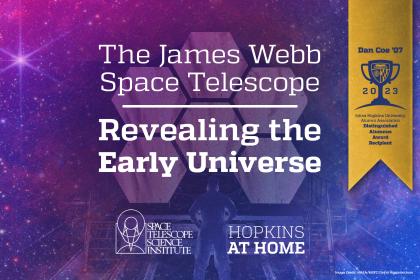Hopkins at Home | The James Webb Telescope: Revealing the Early Universe

Description
With the Hubble Space Telescope, we have looked back in time and witnessed a rich diversity of galaxies growing, merging, and taking shape over 13 billion years of cosmic history. But the most distant galaxies in the early universe are too small and faint to study in detail with Hubble, leaving us with many questions: When did the first stars and galaxies form? Did any early galaxies look like our Milky Way? And what were they made of?
The James Webb Space Telescope is beginning to answer these questions and pose new ones. In only its second year of operation, the James Webb Space Telescope has already taken a giant leap towards discovering the first stars. Dan Coe '07, a recipient of the 2023 Johns Hopkins Distinguished Alumnus Award, will discuss how scientists at the Space Telescope Science Institute made observations using gravitational lensing that reveal individual stars, including Earendel, observed 13 billion years ago, observed star clusters dating back to even earlier times in the Cosmic Gems Arc, and used spectroscopy to reveal heavy elements created by stars less than 400 million years after the Big Bang.
The conversation will be moderated by NASA thermal engineer Emily Maheras, WSE '23 (MA).
This program is presented through Hopkins at Home. Please attend the event by using the livestream link.
Who can attend?
- General public
- Faculty
- Staff
- Students







